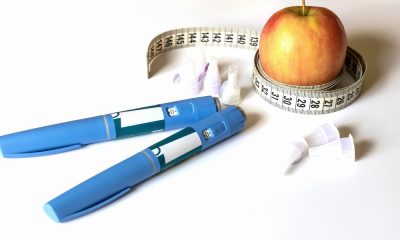Insights
What Agetech trends will we see in 2023?

AgeTech World meets sector experts to predict the trends we are likely to see in 2023, as pressure on the healthcare sector rises.
Our world is going through an unprecedented demographic shift as we’ve never seen so many people reaching old age.
According to the annual State of Ageing report by the Centre for Ageing Better, there are almost 11 million people aged 65 and over in the UK. This equates to around 19 per cent of the UK population.
Estimates suggest that in 10 years this figure will increase to around 22 per cent of the population that will amount to almost 12 million people.
In 2022, the UK has also seen a number of centenarians at its highest level ever, with a 52 per cent increase.
As the UK and the world have seen a huge increase in the average life expectancy, the healthcare sector has been put under pressure. Recent studies have found that healthcare providers do not do enough for older people.
Steve Gates, managing director at TakingCare Personal Alarms, says: “With recent ONS data indicating we have an increasingly ageing population, and the challenges faced by the NHS to support elderly people, more investment is needed into preventative technologies within agetech.”
Agetech as an informative tool

With older people embracing modern technology more than ever before, agetech provides the solution to the issue. In fact, according to recent studies, 77 per cent of over-65s used the internet at home in 2020.
According to the same findings, recent internet usage among women aged 75 and over had more than doubled since 2011.
Therefore, technology is, and can be used to help patients and caregivers become better informed, make better care decisions, and manage medical conditions outside clinical settings.
Gary Steen, chief operating officer at Tunstall Healthcare, says: “The latest evolution of connected care is underpinned by digital technology, providing data and insight to enable more personalised services and predictive solutions, and will open up a new world of possibilities for changing lives and transforming services.”
‘Assistive technology should be recognised as a proactive step’

In 2023, we will see more assistive technology being used as a form of prevention for elderly people. “Assistive technology for older people has evolved a lot over the past decade, and I don’t think we’ll see this evolution slow down any time soon,” says Gates.
“Assistive technology should be recognised as a proactive step, rather than a reactive solution.
“Many people introduce technology into an elderly person’s home after they have experienced a fall or accident, but an increase in digital and AI-led technologies could help reduce the likelihood of these falls, mitigating the risk of injury.”
About 36 million falls are reported among older adults each year, with around three million of them getting treated in emergency departments for fall injuries. Of these falls, one out of five causes an injury.
“Through gazing and exploring key areas to innovate, we can drive the health, housing and care sectors forward, whilst ensuring tech literacy is kept in sharp focus,” says Steen. “I’m building on the collaborations that have already been generated to shape a system that is better able to serve people in such a fast-changing world and ensure the future of technology within the digital health and care space.
“Whether it’s the use of virtual care platforms, remote monitoring solutions, communication tools, digital apps or sophisticated data platforms, services are entering a new phase of digital maturity.”
What is the future of ‘longevity economy’?

As we’ll see an increased use of technology for the care of older people, the ‘longevity economy’ is expected to reach US$200 billion by 2030. ‘Longevity economy’ is defined as the sum of all economic activity serving the needs of older adults.
“Over the next five years we’re going to see both the technology industry and our health and social care services experience continued disruption, and solutions will be revolutionised,” says Steen. “Our technology platforms will be developed to process data from multiple sources and provide a clear picture of the risks someone faces, enabling us to create a model of health and care which is proactive and predictive, rather that reactive.”
Gates concludes: “Assistive technology for older people has evolved a lot over the past decade, and I don’t think we’ll see this evolution slow down any time soon.
“It would be great to see further development and acceptance of these digital technologies within the agetech space as we move into 2023 and beyond, and we’re already seeing more diversity within elderly care technologies and products which I hope will continue.”
News
Childhood loneliness linked to increased risk of dementia, study finds

Childhood loneliness increases the risk of dementia in later life, according to new research.
Adults who recalled being lonely and without a close friend in childhood faced a 41 per cent higher risk of developing dementia, even if they were no longer lonely as adults.
People who frequently felt lonely without close friends during youth showed accelerated cognitive decline — a worsening of memory and thinking — and started middle age with lower scores on these skills.
Researchers from universities in China, Australia and the US, including Harvard and Boston universities, analysed data from 13,592 Chinese adults tracked from June 2011 to December 2018.
The critical factor was the subjective feeling of loneliness itself. Those who reported often feeling lonely as children had a 51 per cent higher dementia risk, even if some had close friends.
However, those who only lacked close friends but did not feel lonely showed no significant difference in risk.
Nearly half of roughly 1,400 adults in the study reported being lonely and without close friends during childhood.
The 4.2 per cent who experienced both faced the highest risk of cognitive decline.
The link to dementia remained strong even for people who were no longer lonely in adulthood, suggesting early-life isolation can have lasting effects on brain health.
During childhood, the brain develops rapidly and is vulnerable to harm. Loneliness acts as a chronic stressor, flooding the developing brain with harmful hormones that can damage memory centres, and it reduces stimulation from social play and peer interaction that helps build robust neural networks.
A separate 2024 study of more than 10,000 older adults found that specific childhood hardships — including poverty, disruptive home environments or parental addiction — were directly linked to poorer cognitive function later in life.
Youth loneliness appears to be rising, partly linked to widespread social media use.
Among girls, 64 per cent aged five to seven, 67 per cent aged eight to 10, and 73 per cent aged 11 to 13 reported feelings of loneliness last year. More than a quarter of boys aged 11 to 17 in the US report feeling lonely.
Children face growing social isolation, with one in four Americans now eating every meal alone — a rate that has surged by over 50 per cent since 2003. Sharing meals with friends and family helps build bonds and positive memories in youth.
Fewer children are playing outside or joining team sports.
A recent study reported that one in three children do not play outside on school days, and one in five do not do so even at weekends.
The 2024 research found a direct, dose-dependent relationship between childhood adversity and cognitive problems in adults — the greater the early trauma, the greater the later risk.
For each significant increase in early trauma, individuals faced an eight per cent higher risk of daily memory issues and scored lower on objective tests of mental speed and focus.
News
Don’t miss you essential monthly agetech update

Your essential monthly update on agetech’s progress
Welcome to your monthly snapshot of the facts, figures, opinions, trends and challenges shaping the development of agetech.
Our new monthly tracker report aims to provide an concise update for busy agetech professionals on the many factors influencing your work.
Here you will find a concise breakdown of deals, developments and opportunities from the last 30 days; and insight and opinion from leading thinkers in the field.
We hope you find something useful and/or inspiring below – and welcome any feedback about what else you’d like to see included.
Independence
Snoring, silence, and the menopause taboo: The hidden health crisis affecting millions

By Professor Ama Johal, clinical lead and dental sleep expert at Aerox Health
During menopause, it’s very common for women to notice significant changes to their sleep patterns and experience things like restless nights, loud snoring, or simply waking up feeling exhausted.
What most don’t realise, however, is that these symptoms can signal something far more serious – obstructive sleep apnoea (OSA), one of the most impactful and consequential sleep-related breathing disorders.
Women across the world are unknowingly fighting an uphill battle. Around 90 per cent of females with moderate to severe sleep apnoea remain undiagnosed.
This collective lack of awareness is due to a plethora of factors including archaic taboos around the subject and lack of education or omission of menopause in sexual education.
Ultimately, this combination leaves women underprepared and vulnerable to the biological, social and medical realities associated with the menopause.
Now more than ever, we must confront this silence head-on and recognise the hidden sleep crisis affecting so many women globally and the opportunity to address it.
The hidden sleep crisis
Snoring that develops or worsens during menopause can progress into OSA due to a decline in estrogen and progesterone which reduces muscle tone in the throat and in turn makes the obstruction or collapse of the airways more likely during sleep.
Yet this link between menopause and sleep disorders remains largely overlooked, leaving millions of women undiagnosed, untreated, and unaware that their sleep struggles are more than just “part of getting older”.
In my practice, I see the consequences of this misunderstanding far too often.
I hear from many female patients who have been suffering in silence, without the knowledge that they could seek help. In fact, I often encounter the common misconception that snoring is a man’s issue.
This preconceived notion perpetuates a persistent gender bias in sleep-related health research.
As ENT consultant and sleep surgeon at University College London hospitals, Ryan Chin Taw Cheong recently highlighted, the development of snoring is reason enough to consult your doctor. It’s time for this pervasive issue to emerge from the dark.
So why don’t women seek help?
When considering why many women do not seek help for their symptoms, there are two overarching reasons.
Firstly, the information and knowledge is not widely available for sufferers to realise that snoring can be a medical issue which can be assessed and subsequently readily treated.
Secondly, there is a potent stigma surrounding both the menopause and snoring which is an inhibiting factor amongst sufferers, discouraging open discussion.
Perhaps unsurprisingly, menopause is not included in traditional sex education in schools. Being unaware of what is ‘normal’ and what could require medical attention is widespread amongst my patients with sleep disorders, yet this information is not freely disseminated outside of clinics.
Unfortunately, cognitive fog and irritability – symptoms of snoring and obstructive sleep apnoea – are too often written off as stress, anxiety or ‘just the menopause’.
Avoiding sharing symptoms with medical providers, combined with online misinformation, often results in individuals suffering in silence or worse, turning to unregulated miracle menopause cures that exacerbate the risks of undiagnosed OSA.
These so-called ‘cures’ reinforce the harmful notion that the menopause is a defect which needs to be fixed rather than a natural life stage.
The health costs of ignoring snoring
A breadth of research links untreated OSA to cardiovascular disease, hypertension and cognitive decline.
However, aside from the medical risks, snoring and sleep apnoea can have profound social and emotional consequences.
For women, the shame in snoring, a symptom often mischaracterised as a ‘male issue’, can significantly affect self esteem and mental health.
Partners may also suffer if the snoring is disruptive to their sleep, in some instances causing rifts in relationships and a phenomena known as ‘sleep divorces’ (sleeping in separate beds or rooms).
In fact, according to a recent study commissioned by 32Co, 47% of recently divorced Brits cite interrupted sleep linked to snoring or sleep disorders as contributing to their relationship breakdowns, with 85 per cent believing ‘sleep divorces’ contributed to ultimate separation.
Sleep specialists seek to manage and monitor the symptoms of sleep disorders and OSA to minimise disruption to an individual’s personal and public life.
Screening menopausal women for OSA is a preventative measure which leads to informed patients. It is not simply about getting better sleep but about the long-term health outcomes.
Breaking the silence: what needs to change
Drawing on the stories of those I meet in my clinic, I would like to outline five steps that we can take to address this silent epidemic.
First, the menopause and associated symptoms should be included in a comprehensive sex and health education.
This could be provided both in schools’ curricula and made readily available at health services catering to adults.
Second, throughout the course of history women’s issues have been chronically underserved.
More resources can be funnelled into conducting research to help us better understand the impact of the menopause on women’s physical and mental health.
Future research would also help to neutralise the gender bias of previous studies.
Third, launching public health campaigns and workplace initiatives to encourage employers to recognise sleep disorders as a significant element of menopause will help build awareness and reduce the impact of stigmas.
Fourth, myth-busting, shattering taboos, and normalising discussion about the menopause will be key.
We must view snoring as a gender neutral issue rather than a male stereotype and denounce harmful rhetoric and jokes that perpetuate stigma.
Fifth, we must better equip more localised healthcare providers up and down the country to both diagnose and treat OSA effectively.
Sleep disorders are not niche issues but a major public health concern with potentially severe consequences.
Quality of life amongst my patients is inextricably linked with sleep quality.
Recognising the relationship between snoring and OSA and the menopause is not simply about pathologising a natural stage of life, but providing women with the information, respect and medical care they deserve.
Only through more transparency and collaboration amongst researchers, educators and clinicians can we hope to close the gender gap in sleep medicine and bring this hidden crisis to light.

 News2 months ago
News2 months agoWeight loss jabs should be first-line obesity treatment in most cases, new guidance states

 News3 weeks ago
News3 weeks agoCzech firm approved for hydrogen Alzheimer’s trial

 News6 days ago
News6 days agoGladys raises £1.5m for AI home care

 News1 month ago
News1 month agoNew drug enhances GLP-1 weight loss without extra added effects, trial finds

 Insights3 weeks ago
Insights3 weeks agoCreativity helps keep the brain young, study finds

 News2 months ago
News2 months agoDrinking even small amounts of alcohol may increase dementia risk, study finds

 News4 weeks ago
News4 weeks agoFamily backs calls for dementia-friendly hospital

 News2 weeks ago
News2 weeks agoLow-dose aspirin beneficial for type 2 diabetes, study finds
































